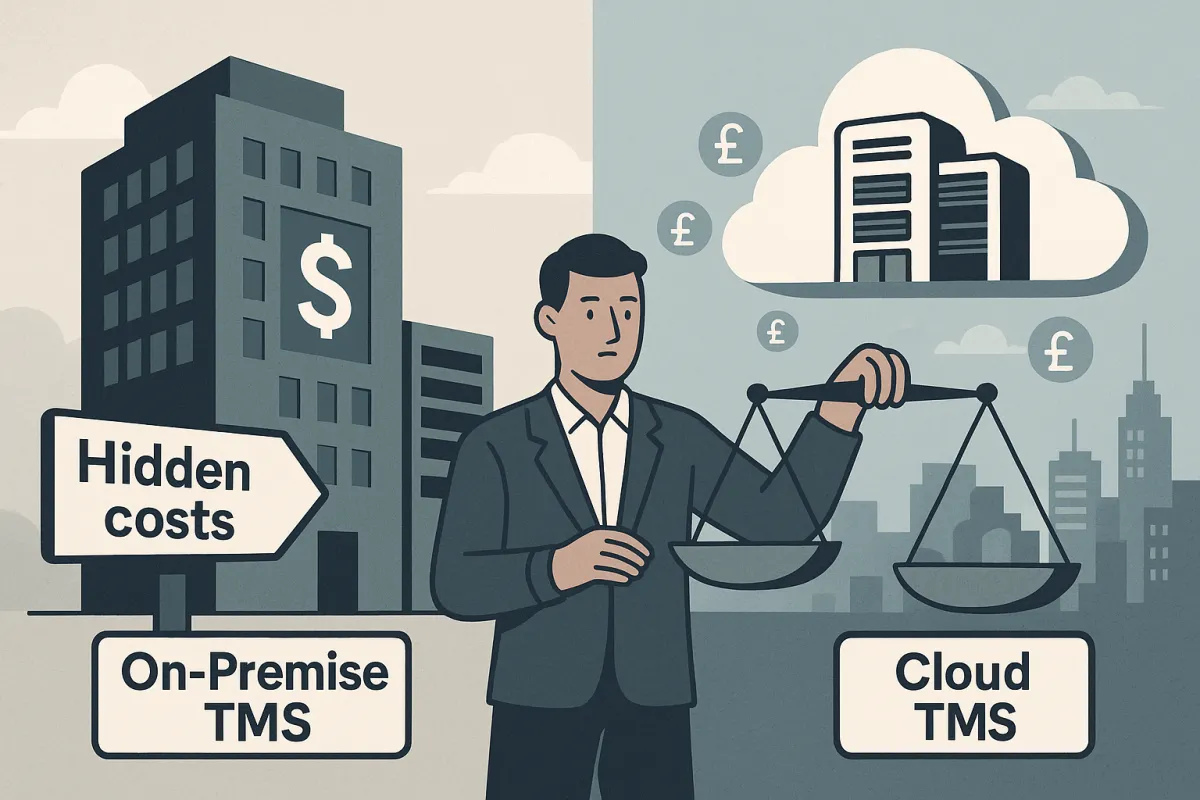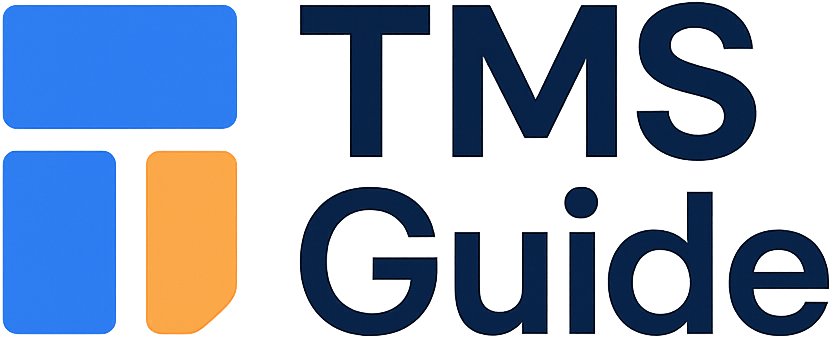Cloud vs On-Premise TMS: The Procurement Decision Matrix That Saves European Shippers £200K+ in Hidden Costs

European shippers are facing a complex procurement challenge that could cost them over £200,000 in hidden expenses. Cloud-based TMS software will run you $2-$5 per load you book or a 5-figure annual subscription cost, while licensed TMS software will run you $50,000-$400,000+ and will often come with annual/monthly maintenance and support fees. Yet most procurement teams lack the structured framework to evaluate these deployment options properly.
The £200K+ Procurement Trap Most Shippers Fall Into
Traditional on-premise TMS solutions carry deceptively high total cost of ownership beyond initial licensing fees. The initial cost of purchasing an on-premise solution can be $10k to even $500k. You purchase the ownership of the software, making it a one-time purchase. But here's where procurement teams get blindsided: Unlike cloud-based solutions, on-premise systems may require additional expenses in IT resources for implementation, ongoing maintenance, and security measures.
The hidden costs multiply quickly. On-premise or licensed TMS models will be a one-time fixed rate that organizations pay up front, plus an annual maintenance charge that ranges from 15-20% of the license costs. You can find prices ranging from $50k all the way to $400k+ for licensed TMS software. Factor in hardware, security infrastructure, dedicated IT staff, and integration complexities, and what seemed like a manageable £100,000 investment becomes a £200,000+ first-year burden.
Cloud deployment pricing models present their own challenges. Cloud TMS Price: Based on number of monthly shipment transactions the cost is $1.00 to $4.00 per freight load booked in the system. For high-volume shippers processing 50,000+ shipments annually, these per-load fees can exceed the cost of enterprise licensing within two years.
The Two-Track Procurement Challenge
The cost of a TMS varies significantly depending on the complexity of features, scalability, implementation requirements, vendor pricing model, and customization needs. Generally, TMS software costs can range from $10,000 – $1M, including upfront licenses, subscription fees, implementation costs, and ongoing maintenance expenses. This massive range reflects the fundamental split between deployment models.
On-premise TMS is installed locally on company servers, offering high control and customization but with higher upfront costs and maintenance responsibilities. Cloud-based TMS is hosted remotely, providing scalability, lower initial costs, and automatic updates, with access from anywhere via the internet.
The procurement challenge intensifies when you consider vendor positioning. Solutions like Cargoson, MercuryGate, and Descartes each offer different cloud-to-enterprise deployment strategies, making direct comparisons difficult without a structured evaluation framework.
The Procurement Decision Matrix Framework
Smart European procurement teams are adopting a four-dimensional evaluation matrix that weighs financial, operational, risk, and strategic factors. This framework addresses the specific challenges facing EU shippers, including GDPR compliance and multi-country operations.
One key aspect of GDPR is data residency, which refers to the requirement for organizations to ensure that personal data is stored and processed within specific geographic locations. The landmark Schrems II judgment by the Court of Justice of the European Union fundamentally impacted these rules. For European shippers, this means cloud deployment decisions must factor in data location and transfer restrictions.
The matrix uses weighted scoring across four dimensions:
- Financial Analysis: Total cost of ownership over 5-year periods, including hidden costs and currency exposure
- Operational Impact: Implementation timelines, user adoption curves, and integration complexity
- Risk Assessment: GDPR compliance, vendor lock-in, and business continuity planning
- Strategic Alignment: Scalability requirements, technology roadmap fit, and growth trajectory planning
Financial Analysis: Beyond the Sticker Price
While the initial investment in an on-premise TMS may be higher, organizations with the necessary IT resources may find that long-term costs are lower compared to ongoing subscription fees for cloud-based services. Over time, the absence of recurring fees can make on-premise solutions more cost-effective.
However, this calculation changes dramatically when you include hidden costs. With a cloud TMS architecture, the buyer is paying only for what they are using on the platform and how much they are using it, while also outsourcing the IT team. There is no need to build an IT staff to support and manage servers, install new users, code and test new functionality, answer user questions, trouble-shoot, etc. With a cloud TMS platform, the IT resource need is supplied by the software company.
For multi-country European operations, currency hedging becomes another consideration. Cloud subscriptions typically price in USD or EUR, creating currency risk for UK-based operations or companies spanning multiple European markets.
Break-even analysis varies significantly by shipment volume. For organizations processing under 10,000 shipments annually, cloud pricing models typically offer better economics. Above 50,000 shipments, on-premise licensing often provides lower total cost of ownership over three-year periods.
Operational Impact Assessment
Here are the main benefits of choosing a Cloud TMS: Fast Setup with Easy Onboarding – No heavy IT infrastructure is required. Most cloud solutions are ready in days, helping teams start faster while avoiding high setup and maintenance costs. This speed advantage translates to 3-6 month implementation timelines for cloud versus 12-18 months for on-premise deployments.
Remote Access Anytime, Anywhere – Dispatchers, drivers, and managers can log in from any location with internet access. This supports carriers managing loads across regions and remote teams. For European operations spanning multiple countries, this accessibility proves valuable for coordinating cross-border shipments.
Change management requirements differ substantially between models. Cloud deployments typically achieve 80%+ user adoption within six months, while on-premise implementations often require 12-18 months for full organizational adoption due to training complexity and system customization requirements.
Risk and Compliance Matrix
GDPR data residency requirements mandate that personal data of EU residents must be stored and processed within specific geographic locations or under adequate safeguards to ensure compliance with data protection laws. GDPR mandates strict data residency requirements, ensuring personal data of EU residents is stored and processed within specific geographic locations or under adequate safeguards.
This creates a critical decision point for European shippers. When personal data is transferred outside the EU, the protection offered by the GDPR should travel with the data. This means that if you export data abroad, your company must ensure one of the following measures are adhered to: The non-EU country's protections are deemed adequate by the EU.
For regulated industries, on-premise deployment often provides the clearest path to compliance. Healthcare, financial services, and defense contractors frequently choose on-premise TMS to maintain direct control over data processing and storage locations.
Vendor lock-in risk assessment requires examining data portability, integration standards, and contract terms. Cloud solutions typically offer easier migration paths but create dependency on vendor infrastructure. On-premise solutions provide data control but may require significant re-implementation costs when switching vendors.
Strategic Fit Analysis
Scalability: Cloud solutions are easily scalable, allowing businesses to adjust their resources as needed. This is especially beneficial for companies experiencing growth or seasonal fluctuations. This scalability advantage becomes particularly relevant for European shippers managing seasonal peaks or expanding into new markets.
Technology roadmap alignment presents another strategic consideration. Studies suggest that businesses can reduce their transportation costs significantly after implementing TMS solutions. Custom TMS solutions offer additional value through specialized features designed for specific business needs. These tailored systems work smoothly with existing business processes while adding advanced capabilities like predictive analytics and AI-driven insights to improve efficiency.
Integration ecosystem planning becomes crucial when evaluating deployment options. Cloud solutions typically offer pre-built integrations with major carriers, customs systems, and ERP platforms. On-premise deployments provide deeper integration capabilities but require more development resources.
The Verdict: Decision Trees by Shipper Profile
Small-medium European shippers processing fewer than 10,000 shipments annually should prioritize cloud deployment. The lower upfront costs, faster implementation, and reduced IT overhead align with resource constraints typical of smaller operations.
Large enterprises processing over 100,000 shipments annually face more complex calculations. Long-Term IT Investment – For large fleets with dedicated IT teams, the upfront cost of an on-premise TMS can balance out over time. Since both the software and infrastructure are owned by the company, it provides complete long-term control.
Hybrid considerations become relevant for enterprises with mixed requirements. Some organizations deploy cloud solutions for standard operations while maintaining on-premise systems for regulated or high-security shipments.
Regulated industries should default toward on-premise deployment unless cloud providers offer specific GDPR compliance guarantees and EU data residency. The regulatory risk often outweighs cost advantages.
When evaluating vendors, consider how solutions like Cargoson, Transporeon, and nShift align with different shipper profiles. Cargoson's cloud-first approach suits growing mid-market shippers, while enterprise-focused vendors may offer stronger on-premise capabilities for large, complex operations.
The decision matrix framework provides the structure European shippers need to avoid the £200,000+ procurement trap. By systematically evaluating financial, operational, risk, and strategic factors, procurement teams can make informed TMS deployment decisions that align with their organization's specific requirements and regulatory obligations.





